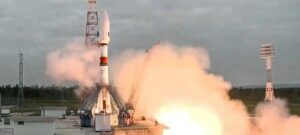“Luna-25” on its way to the Moon
The Russian space agency is aiming to revive the glory days of Soviet space exploration with the “Luna-25” mission, marking the first Russian lunar probe in nearly 50 years. Its primary goal is to collect rock samples from the Moon.
Russia has launched the “Luna-25” spacecraft, making it their first Moon mission in 47 years. The probe, designed to explore the Moon, is scheduled to land at the lunar South Pole and search for water among other objectives. The Soyuz-2.1b carrier rocket, carrying the spacecraft, lifted off as planned from the new Vostochny Cosmodrome in the Amur region at 9:10 local time (01:10 CEST). The Russian space agency, Roscosmos, streamed the launch live. The journey to the Moon’s orbit is expected to take nearly five days, with landing planned around August 21st, according to Roscosmos. An Indian spacecraft, launched on July 14th, is also due to land on the Moon on August 23rd. Launch delayed several times
Technical issues caused multiple delays for this first Russian mission since 1976. The probe was supposed to have been launched much earlier. The initial planned launch date for a lunar probe was in 2012, with May 2022 being the most recent target.
“Luna-25” is a part of Russia’s lunar program, which aims to establish a space station on the Moon by 2040. With this initiative, Russia is building upon its Soviet-era “Luna” program, which also brought lunar soil samples back to Earth. “Luna-25” will collect and analyze soil samples, with the objective of developing technology for a soft landing. Originally, Roscosmos had collaborated with the European Space Agency (ESA) on the Russian lunar program; however, the ESA terminated this partnership following Russia’s invasion of Ukraine over 17 months ago.


